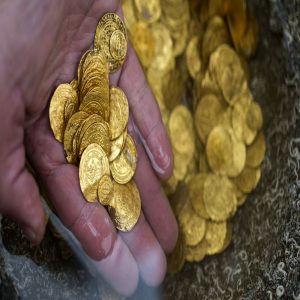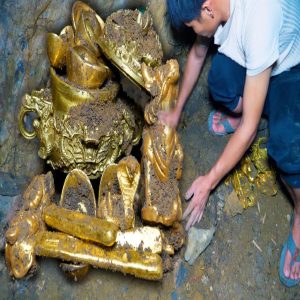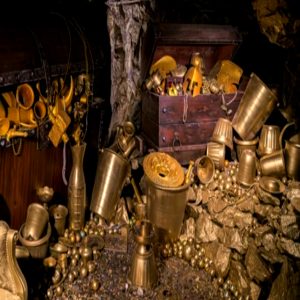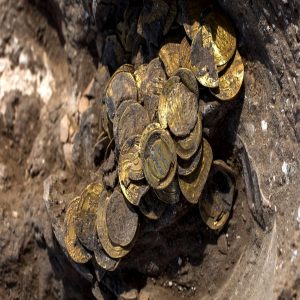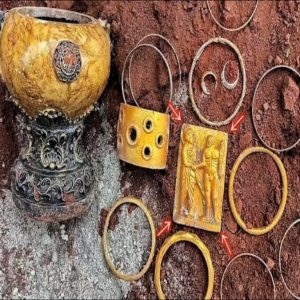Archaeologists have unearthed a whopping treasure trove – approximately 19,000 artifacts spanning from prehistory to the early medieval period at a rare and significant site in the United Kingdom! The oldest artifacts, a series of flint tools, date back to the Mesolithic period, or Middle Stone Age, which in Britain lasted from roughly 10,000 BC to 4,000 BC.
From Prehistory to Anglo-Saxon Times: Historical Spectrum
The excavation also revealed remains from later periods, including remnants of a small settlement from the Late Bronze Age to the Middle/Late Iron Age and an Anglo-Saxon cemetery from the early medieval period. So far, the burial ground has yielded at least 52 individual remains.
These discoveries were made during an excavation at the Calthorpe Gardens residential development, located on the outskirts of the historic market town of Banbury in southern England. Orbit Homes, a house builder, announced the findings in a press release, noting that the excavation took place ahead of the construction of new homes at Calthorpe.
“The grave goods are astounding, just in the volume, their style—there are so many different types of material,” Janice McLeish, director of post-excavation services with Border Archaeology (BA), the consultancy in charge of the excavation, said in an Orbit Homes video. “Within the assemblage, we’ve got glass beads, we’ve got metalwork, we’ve got some pottery. It’s just a really remarkable assemblage to have on one site.”
Artifacts from the Late Bronze Age to Middle/Late Iron Age settlement include handmade pottery and textile tools. The settlement features several large enclosures, likely used as animal pens, along with the remains of roundhouses.
A variety of grave goods were found in the Anglo-Saxon burials, such as bead necklaces, pendants, personal items, and weapons. One of the excavation highlights is a “beautiful” gold pendant with pre-Christian animal iconography, featuring an intertwined serpent design.

Likely gold- or gold-plated pendant recovered from a male grave. ((Youtube Screenshot/ Orbit)
Another notable find is an “exquisite” Iron Age weaving comb, which would have been used in the loom and weaving process, according to McLeish, reports Newsweek.
“Archaeology in itself is exciting, but when you get to cover so many time periods on the one site, it is just such a joy to do. The local area was very rich in archaeology. And the area in particular, on top of that hill has been a focal point since the Mesolithic, and possibly even before that. So people have been attracted to that location for a number of different reasons. And we’re just seeing the glimpses of the people that have left their mark there,” concluded McLeish.

An Iron Age weaving comb with ring and dot motifs is one of several textile tools found. (Youtube Screenshot/ Orbit)
Assessing Grave Burials from Anglo Saxon England
The Anglo-Saxons were a cultural group that emerged in early medieval Britain, originating from various Germanic tribes such as the Angles, Saxons, and Jutes, who migrated to the island following the decline of Roman rule around 410 AD. It would shape the legacy of medieval and modern Britain, lasting until the Norman Conquest of 1066 AD, reports Science Times.
One of the most significant discoveries is the Sutton Hoo ship burial in Suffolk, unearthed in 1939. This royal grave, believed to belong to an East Anglian king, contained an entire ship and a wealth of grave goods, including a highly decorated helmet, weapons, armor, gold jewelry, and intricate metalwork.
In addition to grand burials like Sutton Hoo, everyday items and settlement remains provide insights into the broader Anglo-Saxon society. Excavations at sites such as West Stow in Suffolk and Yeavering in Northumberland reveal the structure of Anglo-Saxon villages, with timber-built houses, communal halls, and agricultural layouts. Objects found at these sites, including pottery, tools, and domestic items, have been reflective of daily life and the community’s self-sufficiency in farming, weaving, and metalworking.
Grave goods from Anglo-Saxon cemeteries often include personal adornments and weapons, indicating social status and personal identity. Brooches, rings, and necklaces, often made of precious metals and stones, were commonly buried with the dead, reflecting both the aesthetic values and the symbolic meanings attached to these objects.

